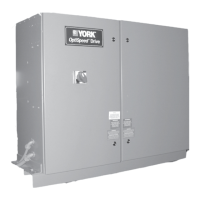JOHNSON CONTROLS
17
SECTION 1 - GENERAL INFORMATION
FORM 160.00-O4
ISSUE DATE: 07/31/2019
1
The names for the above data were changed because
the temperature sensor is now inside the transistor
module instead of the chill plate where the transistor
modules are mounted. This new sensor gives a better
indication of true temperature of the power electronics.
OptiView Control Panel VSD Functions
Refer to the specific OptiView™ Control Panel opera-
tions manual for detailed information. All of the OSCD
related information is contained under the Motor and
Compressor Screens.
VSD ADAPTIVE CAPACITY CONTROL
The YORK® OptiSpeed™ Compressor Drive utilizes
a different approach to speed reduction compared to
earlier variable speed products. There is no longer a
pre-programmed surge map – the YORK® adaptive
system experiments with the speed and vanes to find
the optimum speed for any given condition. It does not
always encounter a “Surge” in the process, but when
it does, the Adaptive Capacity Control (ACC) stores
into memory, the conditions surrounding the Surge,
and therefore remembers to avoid the stored operating
point anytime in the future.
Early versions of the ACC software required that the
drive always start and run up to full speed. ACC soft-
ware starting with version C.ACC.01.04 applies a new
slow ramp up of the drive speed. This new software
lowers the peak current demand from the drive during
start up, saves additional energy, and reduces the pos-
sibility of the chiller running in a stall condition.
The new software will quickly ramp the compressor
speed up to 1/2 speed, and then it takes 5 minutes to
ramp up to full speed. During this slow ramp up pe-
riod the vanes will open to meet the cooling demand.
If the leaving chilled liquid temperature is within +0.5
or lower of the leaving chilled liquid temperature
setpoint, then the drive speed will stop increasing the
RPM of the compressor motor, and start to search for a
surge map point. On extremely hot days the chiller may
surge during the slow ramp period. The new software
has a method to limit the surging. If 2 surges were to
occur during the slow ramp period, then the speed of
the drive will increase to full speed.
Now that the ACC function is provided by the mi-
croboard in the OptiView panel future control changes
will be covered by the operation manual for the chill-
er model of interest. All versions of software require
two conditions to be met for speed reduction to occur.
These two conditions are:
Setpoint Requirements
The leaving chilled liquid temperature must be
within +0.5 °F or lower from the leaving chilled
liquid temperature setpoint. A programmable val-
ue is now available through the OptiView panel
on software versions C.OPT.01.21.307 for the YK
chiller. This programmable value is not available
on the YT chiller. Speed reduction will not occur
until the leaving chilled liquid temperature reach-
es this range.
Stability Requirements
The leaving chilled liquid temperature must be
stable. Lack of stability will be indicative of the
vanes hunting, the leaving chilled liquid tempera-
ture varying, and the green LED on the ACC will
be on. Once the above conditions are met, the ACC
may begin to lower the speed of the compressor
motor 1/10 of a hertz at a time. As the ACC lowers
the speed, the leaving chilled liquid temperature
will begin to creep up. As this occurs, the con-
trol center will begin to open the vanes slightly,
just enough to maintain the leaving chilled liquid
temperature within +/- 0.5°F of the leaving chilled
liquid temperature setpoint. The ACC will contin-
ue to lower speed, with the leaving chilled liquid
temperature control in turn driving the vanes to
a more open position. This process will continue
until one of three following situations occur. This
setting is no longer available after software ver-
sion C.OPT.01.21.307 for the YK chiller.
Full Open Vane Operation
Once the vanes reach the full open position, the ACC
knows it can no longer reduce speed and maintain the
leaving chilled liquid temperature setpoint. The ACC
will maintain operation at this point, with the vanes full
open, and the speed at the last point reached when the
vanes hit 100%. If there is an increase in load while at
this point, the ACC will increase speed until the vanes
are closed to 95% of open. The ACC will then be al-
lowed to continue to reduce speed again.
Effects of Surge
If in the process of reducing speed and opening vanes
the compressor should surge, the ACC will boost the
speed up by 0.8 Hz. The ACC will store in memory a
value that represents the ratio of condenser pressure to
evaporator pressure, the vane position, and the speed of
the drive. The ratio of condenser pressure to evaporator
pressure is displayed as Delta P/P on the Control Panel.

